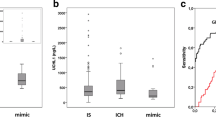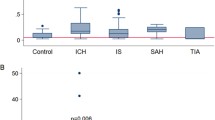Abstract
Background
Epilepsy is a common neurological disease that has a negative impact on physical, social, and cognitive function. Seizure-induced neuronal injury is one of the suggested mechanisms of epilepsy complications. We aimed to evaluate the circulating level of glial fibrillary acidic protein (GFAP) and ubiquitin carboxy-terminal hydrolase-L1 (UCH-L1) as markers of neuronal damage in children with epilepsy and its relation to epilepsy characteristics.
Study design
Methods
This case control study included 30 children with epilepsy and 30 healthy children as a control group. Seizure severity was determined based on Chalfont score. Serum level of GFAP and UCH-L1were measured, and their associations with epilepsy characteristics were investigated.
Results
Circulating levels of GFAP and UCH-L1 were significantly higher in children with epilepsy than in controls (17.440 ± 6.74 and 5.700 ± 1.64 vs 7.06 ± 3.30 and 1.81 ± 0.23, respectively) especially in those with generalized and active seizures. GFAP and UCH-L1 were significantly correlated to the severity of seizures in the previous 6 months. Elevated GFAP level was a predictor for active seizures (OR 1.841, 95%CI 1.043–3.250, P = 0.035).
Conclusion
Circulating GFAP and UCH-L1 expression is increased in children with epilepsy especially those with active seizures.
Significance
GFAP and UCH-L 1may serve as peripheral biomarkers for neuronal damage in children with epilepsy that can be used to monitor disease progression and severity for early identification of those with drug-resistant epilepsy and those who are in need for epilepsy surgery.
Similar content being viewed by others
Change history
25 March 2021
A Correction to this paper has been published: https://doi.org/10.1007/s00381-021-05136-5
References
Jones JE, Asato MR, Brown MG, Doss JL, Felton EA, Kearneyet JA et al (2020) Epilepsy benchmarks area IV: limit or prevent adverse consequence of seizures and their treatment across the life span. Epilepsy Curr 20(1_suppl):31S–39S
Mao XY, Zhou HH, Jin WL (2019) Redox-related neuronal death and crosstalk as drug targets: focus on epilepsy. Front Neurosci 13:512
Sculier C, Gaínza-Lein M, Sánchez Fernández I, Loddenkemper T (2018) Long-term outcomes of status epilepticus: a critical assessment. Epilepsia 59 Suppl 2(Suppl Suppl 2):155–169
Patel DC, Tewari BP, Chaunsali L, Sontheimer H (2019) Neuron–glia interactions in the pathophysiology of epilepsy. Nat Rev Neurosci 20:282–297
Bishop P, Rocca D, Henley JM (2016) Ubiquitin C-terminal hydrolase L1 (UCH-L1): structure, distribution and roles in brain function and dysfunction. Biochem J 473(16):2453–2462
Wang KK, Yang Z, Sarkis G, Torres I, Raghavan V (2017) Ubiquitin C-terminal hydrolase-L1 (UCH-L1) as a therapeutic and diagnostic target in neurodegeneration, neurotrauma and neuro-injuries. Expert Opin Ther Targets 21(6):627–638
Papa L, Mittal MK, Ramirez J, Silvestri S, Giordano P, Braga CF, Tan CN, Ameli NJ, Lopez MA, Haeussler CA, Mendez Giordano D, Zonfrillo MR (2017) Neuronal biomarker ubiquitin C-terminal hydrolase detects traumatic intracranial lesions on computed tomography in children and youth with mild traumatic brain injury. J Neurotrauma 34(13):2132–2140
Yang Z, Wang KK (2015) Glial fibrillary acidic protein: from intermediate filament assembly and gliosis to neurobiomarker. Trends Neurosci 38(6):364–374
Petzold A (2015) Glial fibrillary acidic protein is a body fluid biomarker for glial pathology in human disease. Brain Res 1600:17–31
Hol EM, Pekny M (2015) Glial fibrillary acidic protein (GFAP) and the astrocyte intermediate filament system in diseases of the central nervous system. Curr Opin Cell Biol 32:121–130
Bazarian JJ, Biberthaler P, Welch RD, Lewis LM, Barzo P, Bogner-Flatz V, Gunnar Brolinson P, Büki A, Chen JY, Christenson RH, Hack D, Huff JS, Johar S, Jordan JD, Leidel BA, Lindner T, Ludington E, Okonkwo DO, Ornato J, Peacock WF, Schmidt K, Tyndall JA, Vossough A, Jagoda AS (2018) Serum GFAP and UCH-L1 for prediction of absence of intracranial injuries on head CT (ALERT-TBI): a multicentre observational study. Lancet Neurol 17(9):782–789
Scheffer IE, Berkovic S, Capovilla G, Connolly MB, French J, Guilhoto L, Hirsch E, Jain S, Mathern GW, Moshé SL, Nordli DR, Perucca E, Tomson T, Wiebe S, Zhang YH, Zuberi SM (2017) ILAE classification of the epilepsies: position paper of the ILAE Commission for Classification and Terminology. Epilepsia. 58(4):512–521
Duncan JS, Sander JW (1991) The chalfont seizure severity scale. J Neurol Neurosurg Psychiatry 54(10):873–876
Wang KK, Yang Z, Zhu T, Shi Y, Rubenstein R, Tyndall JA et al (2018) An update on diagnostic and prognostic biomarkers for traumatic brain injury. Expert Rev Mol Diagn 18(2):165–180
Mondello S, Palmio J, Streeter J, Hayes RL, Peltola J, Jeromin A (2012) Ubiquitincarboxy-terminal hydrolase L1 (UCH-L1) is increased in cerebrospinal fluid and plasma of patients after epileptic seizure. BMC Neurol 12:85
Simani L, Elmi M, Asadollahi M (2018) Serum GFAP level: a novel adjunctive diagnostic test in differentiate epileptic seizures from psychogenic attacks. Seizure. 61:41–44
Li Y, Wang Z, Zhang B, Zhe X, Wang M, Bai J, Lin T, Zhang S (2013) Cerebrospinal fluid ubiquitin C-terminal hydrolase as a novel marker of neuronal damage after epileptic seizure. Epilepsy Res 103(2–3):205–210
Chmielewska N, Maciejak P, Turzyńska D, Sobolewska A, Wisłowska-Stanek A, Kołosowska A et al (2019) The role of UCH-L1, MMP-9, and GFAP as peripheral markers of different susceptibility to seizure development in a preclinical model of epilepsy. J Neuroimmunol 332:57–63
Gurnett CA, Landt M, Wong M (2003) Analysis of cerebrospinal fluid glial fibrillary acidic protein after seizures in children. Epilepsia. 44(11):1455–1458
Martinian L, Boer K, Middeldorp J, Hol EM, Sisodiya SM, Squier W et al (2009) Expression patterns of glial fibrillary acidic protein (GFAP)-delta in epilepsy-associated lesional pathologies. Neuropathol Appl Neurobiol 35(4):394–405
Stringer JL (1996) Repeated seizures increase GFAP and vimentin in the hippocampus. Brain Res 717(1–2):147–153
Zhu M, Chen J, Guo H, Ding L, Zhang Y, Xu Y (2018) High mobility group protein B1 (HMGB1) and interleukin-1β as prognostic biomarkers of epilepsy in children. J Child Neurol 33(14):909–917
Deleo F, Thom M, Concha L, Bernasconi A, Bernhardt BC, Bernasconi N (2018) Histological and MRI markers of white matter damage in focal epilepsy. Epilepsy Res 140:29–38
Gan ZS, Stein SC, Swanson R, Guan S, Garcia L, Mehta D, Smith DH (2019) Blood biomarkers for traumatic brain injury: a quantitative assessment of diagnostic and prognostic accuracy. Front Neurol 10:446
McCormack M, McGinty RN, Zhu X, Slattery L, Heinzen EL, EPIGEN Consortium, Costello DJ et al (2020) De-novo mutations in patients with chronic ultra-refractory epilepsy with onset after age five years. Eur J Med Genet 63(1):103625
Atalar AÇ, Vanlı-Yavuz EN, Yılmaz E, Bebek N, Baykan B (2020) Long-term follow-up of a large cohort with focal epilepsy of unknown cause: deciphering their clinical and prognostic characteristics. J Neurol 267(3):838–847
Author information
Authors and Affiliations
Corresponding author
Additional information
Publisher’s note
Springer Nature remains neutral with regard to jurisdictional claims in published maps and institutional affiliations.
Rights and permissions
About this article
Cite this article
Elhady, M., Youness, E.R., AbuShady, M.M. et al. Circulating glial fibrillary acidic protein and ubiquitin carboxy-terminal hydrolase-L1 as markers of neuronal damage in children with epileptic seizures. Childs Nerv Syst 37, 879–884 (2021). https://doi.org/10.1007/s00381-020-04920-z
Received:
Accepted:
Published:
Issue Date:
DOI: https://doi.org/10.1007/s00381-020-04920-z




